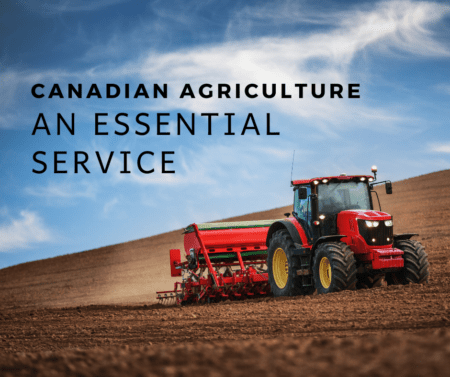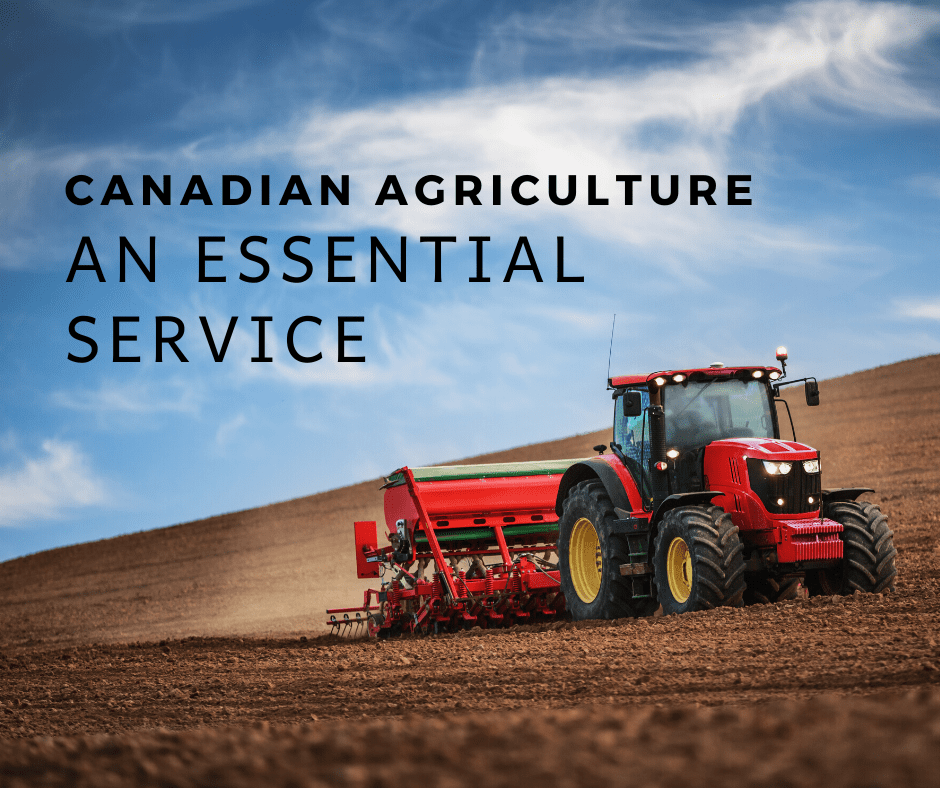As an essential service, this spring farmers enter a season of more uncertainties than normal
In the last few weeks, the Covid-19 crisis has impacted every segment of Canada’s economy. A month ago, on March 25, the Government of Saskatchewan released their list of essential services that can continue operation with social-distancing measures in place. Unsurprisingly, among that shortlist were the production, processing, and supply chains of the agriculture sector. Despite the chaos in the world right now, everyone still needs to eat.
 Farmers under normal circumstances enjoy the peace and quiet of country life. So one may assume that during times of ‘social-distancing’, farmers would be relatively unaffected. While social distancing is a natural part of life in the country, the effects of the Covid-19 crisis will not go unnoticed this growing season.
Farmers under normal circumstances enjoy the peace and quiet of country life. So one may assume that during times of ‘social-distancing’, farmers would be relatively unaffected. While social distancing is a natural part of life in the country, the effects of the Covid-19 crisis will not go unnoticed this growing season.
Day-to-Day Operations
It’s too early to know just how Covid-19 will affect our local producers, but we can assume it will depend on multiple factors including farm size; varying scales of farm operations will experience the impacts of the crisis differently. All farms will do their best to maintain social distance, but this may be easier for smaller farms that have fewer people involved in day-to-day operations, often living within the same household. The difficulty of social distancing may not exist to the same degree as for larger operations with many farm employees coming and going. Enhanced cleaning or sanitation measures for all shared equipment and workspaces will be important for these larger operations.
Learning on the job will also become more challenging for seasonal employees. Training equipment operators often requires riding in the machinery with the trainee, yet the recommended 6-ft separation distance will be difficult to maintain inside of a tractor cab. Additionally, some Canadian farms rely on the Seasonal Agricultural Workers Program to fill their labour needs. This is especially true for horticultural operations, such as vegetable farms, with heightened labour requirements. These temporary foreign workers are allowed to cross the Canadian border with the new travel restrictions in place, yet spring operations may be slowed with the mandatory 14-day isolation period following their arrival. It’s still unknown how seamless this process will be.
The effects of the virus will also be felt in the delivery or pick-up of seed, chemical, and fertilizer. Most agricultural input retailers have measures in place to limit interaction between employees and customers, including reduced site access. They have also adopted the advancements in e-business, which will allow producers to carry out online ordering, invoicing and payments. Also, many retailers are offering deliveries of inputs, which can be completed without any interaction between the transporter and the farmer.
With the current restrictions on face-to-face social interaction, digital technologies will be very important for farmers. Communication via text or phone call will be essential to getting the seed in the ground efficiently, especially as the complexity of the operation and number of employees increases. Routine meetings may occur via conference calls or group emails. Training new employees may also be done digitally through online tutorials or video calls. The huge technological advancements in recent years will help to ease the burden of the pandemic for our farmers.
Bringing the Crop to Market
Even after overcoming the challenges of seeding, more road bumps lie ahead for farmers in the 2020 growing season. After planting, growing, and harvesting, the crop must still be marketed. Grain elevators continue to accept deliveries regularly, but with implemented safety measures to maintain distance between employees and customers. Farmers and truckers are being asked to remain inside their trucks, and paperwork and transactions are occurring electronically. Additionally, most elevators are asking farmers to call or text ahead of visiting the site and access may be limited.
One uncertainty farmers face is the future of commodity prices. We saw oil prices plummet into the negative in April, the stock market is facing uncertainty, and global economic instability suggests that commodity markets will be volatile. Though the weak Canadian dollar and constant demand for food provide hope that grain prices may not head south, the effects of the crisis on grain markets are yet to be seen. Some farmers are trying to move their grain to port while prices are still relatively stable. However, lower interest rates may also result in farmers holding onto grain stocks in anticipation of further chaos. This stock-holding behaviour may offset some of the price decreases experienced. The uncertainty of the grain markets adds another element of risk to the already complex year ahead for Canadian farmers.
Effects on Other Sectors of Canadian Agriculture
When reflecting on Covid-19’s effects on agriculture, large grain operations likely spring to mind; however, other facets of agriculture will be impacted as well. Many specialty operations, including fruit and vegetable farms, sell directly to restaurants or food processors or rely on farmers’ markets. These operations will certainly be affected as restaurants and other businesses in the food industry close their doors or offer limited services. Currently, the Prairie Fresh Food Corporation helps many local fruit and vegetable farmers sell produce to local Co-op food stores across the prairies. During this challenging time, affected producers may be able to join this corporation or form something similar to help secure a place in the grocery stores for their produce.
Horticultural markets and greenhouses are another aspect of agriculture likely to take a hit as a result of this crisis. People are being encouraged to stay home except for essential outings and this will likely result in diminished demand for spring planters. Greenhouses and flower shops will also likely see reduced demand or order cancellations for spring flower arrangements, especially with the cancellation of large celebrations. In the coming weeks, we will see if our local greenhouses offer online markets and timed pickup or drop-off services to help keep their businesses afloat.
Lastly, the livestock market continues, but faces great pressures. Since most of us purchase our meat from grocery stores, we rely on the large slaughter and processing plants to fill the supply chain. In facilities like the Cargill meat processing plant in Alberta, which produces 40% of Canada’s cattle, it will take time to regain high efficiency and output. At these facilities, staff numbers have to be reduced for safety reasons, which means retraining for different lines, in addition to slower production time. While our national facilities implement new protocols for slaughter and processing to ensure their staff and consumers’ safety, we could see both a small reduction in meat and producers holding more cattle for the time being. However, calving doesn’t stop in a pandemic, and so our ranchers continue on. We will see in the coming months how our supply chain, production, and trade impact out local livestock producers.
Only Time Will Tell
Unfortunately, no one knows how long the present measures to curb the spread of the virus will be in place. However, as winter turns to spring, we can be certain that seeding is beginning for farms across Saskatchewan. With the closure of businesses not deemed essential, we can say with certainty that our farmers, and the agricultural industry in general, are essential to the lives of Canadians. We may not have social gatherings or access to many services we are used to enjoying, but every day, we will have access to safe, nutritious food grown by Canadian farmers.



Pingback: Canadian Agriculture and Border Closures - SAIFood
Pingback: Canadian Agriculture and Border Closures – Technology
Pingback: Canadian Agriculture and Border Closures - HAPPSHOPPERS
Pingback: Canadian Agriculture and Border Closures – iVistics
Pingback: Canadian Agriculture and Border Closures – My Blog
Pingback: Canadian Agriculture and Border Closures – Aerospace
Pingback: Canadian Agriculture and Border Closures | BOBBY HILL.COM
Pingback: Canadian Agriculture and Border Closures – Live News 2 Go Agriculture
Pingback: Canadian Agriculture and Border Closures – Agriculture